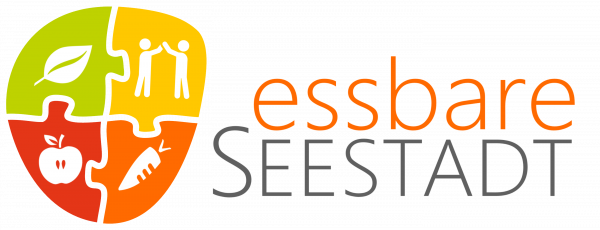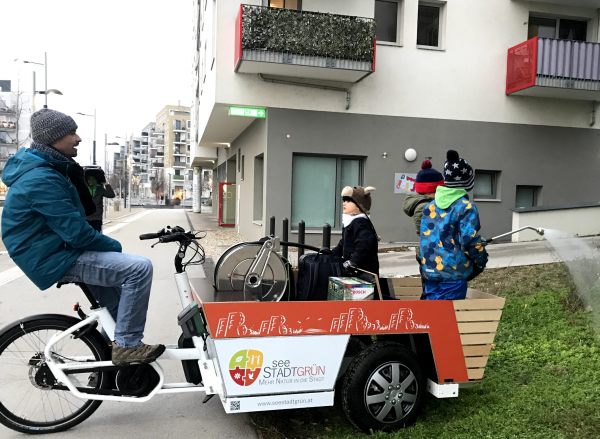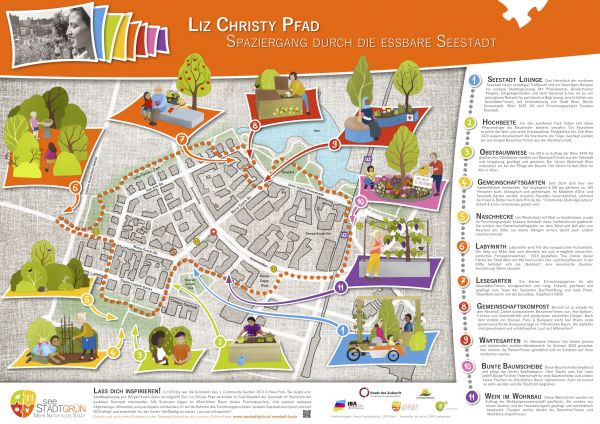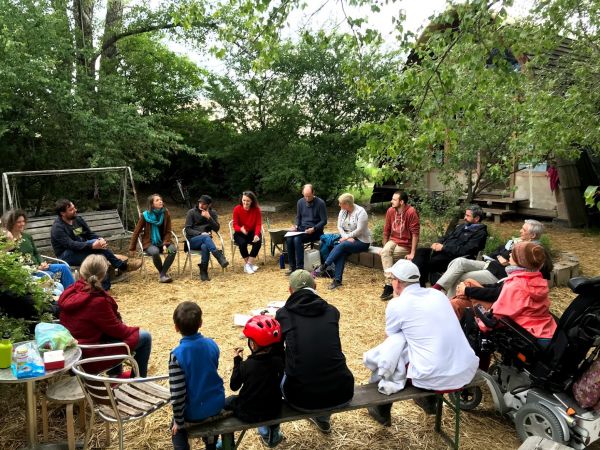Edible Seestadt - Green Seestadt - Learning for the Edible City of the Future
Short Description
Status
completed
Initial Situation
To the question of how contemporary urban development can address climate change, even newly developed urban districts and showcase projects provide only tentative answers. Seestadt Aspern – Smart Cities model region and urban development showcase project of Vienna – strives to break new ground and shows comparatively high standards with regard to investments for development of green spaces. Nevertheless, apart from the spacious Seepark, asphalt, stone and concrete dominate the image of public spaces that offer little refuge from heat in summer. The recently completed Seeparkquartier draws criticism due to the extensive use of dark asphalt for paved surfaces (Scherer 2020). Construction and maintenance costs, planning challenges, and complex coordination processes regarding liability issues and areas of responsibility of public agencies are just some of the inhibiting factors that make climate-effective greening of urban neighborhoods difficult. Greening projects initiated by civil society and designed in a participatory or co-creative manner could bring a breath of fresh air into urban development and open new perspectives, solutions and paths.
Motivation and Research Question
Many residents have moved to Seestadt Aspern hoping for a green neighborhood. The project "essbare Seestadt" was initiated by a concerned and committed resident who did not want to stand back and watch the large-scale soil sealing in the Seestadt, but wanted to draw attention to the development, look for allies and bring about changes for a green and edible Seestadt. She found support from actors of vienna.transitionBASE, an interim use project in which strategies of the post-growth economy were tested until October 2020 and which had already established a network of research partners. The resulting "essbare Seestadt" project sought to answer the questions of how citizen-led, bottom-up greening could work, what effects this would have on quality of life, biodiversity, climate effectiveness, and costs, what difficulties are encountered, how they can be overcome, and what preconditions and, in particular, negotiation processes are needed to enable a greener and edible city.
Project Content, Objectives and Methodological Procedure
In order to address these questions, the first two expansion stages of the Seestadt were used as a real laboratory for co-creatively implemented edible greening pilot projects and an inter- and transdisciplinary consortium was formed, which included civil society organizations, residents, a planning office as well as institutes for social science, planning and ecological research. The first step of the research was socio-spatial exploration and analysis. The social and spatial potential on site was identified and compared with the general potential of (climate) resilience-promoting interventions, which was determined by best-practice analyses. Based on the results, building blocks and tools for edible neighbourhoods and regions were elaborated and a rough scheme was developed ('open concept'), which formed the agile planning basis and working thesis for the subsequent co-creative implementation process. Central to this process was the intensive involvement and engagement of local residents and all relevant stakeholders, whereby a comprehensive inventory of methods was developed and tested.
Results and Conclusions
Citizen engagement in urban development is desirable, possible, enriching and has a high untapped potential. Positive impact can be demonstrated in the increase of social capital, quality of life, biodiversity, cost savings and climate impacts. During the co-creation process, 21 pilot projects were implemented in the Seestadt. Most of them were connected by the Liz Christy Trail – an experiential trail for edible cities and communities. The quintessence of the research results were worked into a community-oriented 'Guide for Green and Edible Projects and Open Spaces'. This guide is intended to serve as a basis and manual for actors to make their environment more livable and climate-friendly.
Outlook
The "essbare Seestadt" project marks the first steps on a path that began with participatory green space design and is now leading to a co-creative future. Developments that are necessary to activate unused potential have become increasingly apparent in the course of the project. There is a need for:
- improved coordination between city administration and civil society – mutual understanding and trust ought to be built and deepened,
- structures, e. g. in the form of cooperation and communication platforms or interfaces, which integrate existing practices and innovation approaches,
- further participation formats for transparent participation processes, which structurally enable a diverse interaction with reduced friction between the city and civil society,
- the interconnection of natural science, social science and economic research approaches in order to be able to systematically document and multiply the effects of urban gardening and citizen engagement,
- Jurisprudential analyses and catalogs of recommendations for legislation, in order to comprehensively record legal hurdles for participatory urban development and to identify alternatives and
- Financing models that enable 'smart citizens' to act as economically emancipated actors on an equal footing.
These measures could lead to a culture of co-creation, characterized by trust and mutual appreciation of the groups of actors involved and an understanding of viable paths, and in which 'smart citizens' establish themselves as initiators and partners in the design of sustainable living environments.
Project Images
Terms of use: The pictures listed underneath the header “Project Pictures” originate from the projects in the frame of the programmes City of Tomorrow, Building of Tomorrow and the IEA Research Cooperation. They may be used credited for non-commercial purposes under the Creative Commons License Attribution-NonCommercial (CC BY-NC).
Project Partners
Project management
United Creations
Project or cooperation partners
- BOKU - Institut für Landschaftsplanung (ILAP)
- Forschungsinstitut für biologischen Landbau (FiBL) Österreich
- Institut für partizipative Sozialforschung (IPS)
- Gartenpolylog
- Seestadtgarten
- PlanSinn Planung und Kommunikation GmbH
Contact Address
Mag. David Marek
Schopenhauerstraße 17/6
1180 Wien
Tel.: +43 (676) 473 64 70
E-mail: david.marek@unitedcreations.org
Web: www.t-base.org
Web: www.essbareseestadt.at




